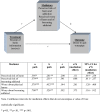Affecting perceptions of harm and addiction among college waterpipe tobacco smokers
- PMID: 21471304
- PMCID: PMC3129239
- DOI: 10.1093/ntr/ntr049
Affecting perceptions of harm and addiction among college waterpipe tobacco smokers
Abstract
Introduction: The spread of waterpipe tobacco use among youth may be due in part to perceptions that waterpipe tobacco use is safer than other tobacco products, such as cigarettes. In two pilot studies, we sought to modify college waterpipe smokers' perceived risks and worry about waterpipe tobacco smoking.
Methods: We conducted two web-based studies that varied whether college waterpipe users received information on (a) spread of and use of flavored tobacco in waterpipe and (b) harms of waterpipe smoking. Study 1 (N = 91) tested the "incremental" effects on perceptions of risk and worry of adding information about harms of waterpipe smoking to information on the spread of waterpipe and use of flavorings in the tobacco. Study 2 (N = 112) tested the effects on perceptions of risk and worry of reviewing information about harms of waterpipe smoking compared to a no information control group. In Study 1 only, we assessed as part of a 6-month follow-up (n = 70) the percentage of participants who reported no longer using waterpipe.
Results: Pooling data from both studies, participants who received information about the harms of waterpipe smoking reported greater perceived risk and worry about harm and addiction and expressed a stronger desire to quit. In Study 1, 62% of participants in the experimental group versus 33% in the control group reported having stopped waterpipe use.
Conclusions: These are the first studies to show that perceptions of addiction and harm from waterpipe use can be modified using minimally intensive interventions; such interventions show promise at decreasing waterpipe use.
References
-
- Akl EA, Gaddam S, Gunukula SK, Honeine R, Jaoude PA, Irani J. The effects of waterpipe tobacco smoking on health outcomes: A systematic review. International Journal of Epidemiology. 2010;39:834–857. doi:10.1093/ije/dyq002. - PubMed
-
- American Lung Association. 2007. An emerging deadly trend: Waterpipe tobacco use. Tobacco policy trend alert. Retrieved from http://slati.lungusa.org/alerts/TrendAlert_Waterpipes.pdf.
-
- Caraballo RS, Novak SP, Asman K. Linking quantity and frequency profiles of cigarette smoking to the presence of nicotine dependence symptoms among adolescent smokers: Findings from the 2004 National Youth Tobacco Survey. Nicotine & Tobacco Research. 2009;11:49–57. doi:10.1093/ntr/ntn008. - PubMed
Publication types
MeSH terms
Grants and funding
LinkOut - more resources
Full Text Sources
Medical


